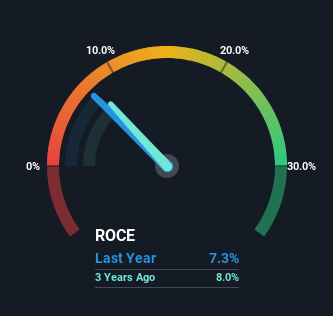- Israel
- /
- Aerospace & Defense
- /
- TASE:ESLT
Here's What's Concerning About Elbit Systems' (TLV:ESLT) Returns On Capital

What trends should we look for it we want to identify stocks that can multiply in value over the long term? Typically, we'll want to notice a trend of growing return on capital employed (ROCE) and alongside that, an expanding base of capital employed. Ultimately, this demonstrates that it's a business that is reinvesting profits at increasing rates of return. In light of that, when we looked at Elbit Systems (TLV:ESLT) and its ROCE trend, we weren't exactly thrilled.
Return On Capital Employed (ROCE): What Is It?
Just to clarify if you're unsure, ROCE is a metric for evaluating how much pre-tax income (in percentage terms) a company earns on the capital invested in its business. The formula for this calculation on Elbit Systems is:
Return on Capital Employed = Earnings Before Interest and Tax (EBIT) ÷ (Total Assets - Current Liabilities)
0.073 = US$348m ÷ (US$9.6b - US$4.8b) (Based on the trailing twelve months to September 2023).
Thus, Elbit Systems has an ROCE of 7.3%. Ultimately, that's a low return and it under-performs the Aerospace & Defense industry average of 12%.
See our latest analysis for Elbit Systems

In the above chart we have measured Elbit Systems' prior ROCE against its prior performance, but the future is arguably more important. If you'd like, you can check out the forecasts from the analysts covering Elbit Systems for free.
What The Trend Of ROCE Can Tell Us
When we looked at the ROCE trend at Elbit Systems, we didn't gain much confidence. Over the last five years, returns on capital have decreased to 7.3% from 11% five years ago. On the other hand, the company has been employing more capital without a corresponding improvement in sales in the last year, which could suggest these investments are longer term plays. It may take some time before the company starts to see any change in earnings from these investments.
Another thing to note, Elbit Systems has a high ratio of current liabilities to total assets of 50%. This effectively means that suppliers (or short-term creditors) are funding a large portion of the business, so just be aware that this can introduce some elements of risk. Ideally we'd like to see this reduce as that would mean fewer obligations bearing risks.
What We Can Learn From Elbit Systems' ROCE
To conclude, we've found that Elbit Systems is reinvesting in the business, but returns have been falling. Since the stock has gained an impressive 64% over the last five years, investors must think there's better things to come. But if the trajectory of these underlying trends continue, we think the likelihood of it being a multi-bagger from here isn't high.
One more thing to note, we've identified 1 warning sign with Elbit Systems and understanding this should be part of your investment process.
For those who like to invest in solid companies, check out this free list of companies with solid balance sheets and high returns on equity.
Valuation is complex, but we're here to simplify it.
Discover if Elbit Systems might be undervalued or overvalued with our detailed analysis, featuring fair value estimates, potential risks, dividends, insider trades, and its financial condition.
Access Free AnalysisHave feedback on this article? Concerned about the content? Get in touch with us directly. Alternatively, email editorial-team (at) simplywallst.com.
This article by Simply Wall St is general in nature. We provide commentary based on historical data and analyst forecasts only using an unbiased methodology and our articles are not intended to be financial advice. It does not constitute a recommendation to buy or sell any stock, and does not take account of your objectives, or your financial situation. We aim to bring you long-term focused analysis driven by fundamental data. Note that our analysis may not factor in the latest price-sensitive company announcements or qualitative material. Simply Wall St has no position in any stocks mentioned.
About TASE:ESLT
Elbit Systems
Develops and supplies a portfolio of airborne, land, and naval systems and products for the defense, homeland security, and commercial aviation applications primarily in Israel, North America, the Asia-Pacific, Europe, Latin America, and internationally.
Flawless balance sheet with solid track record.


